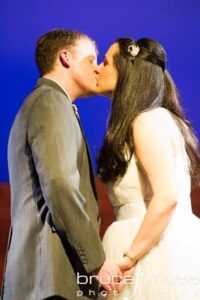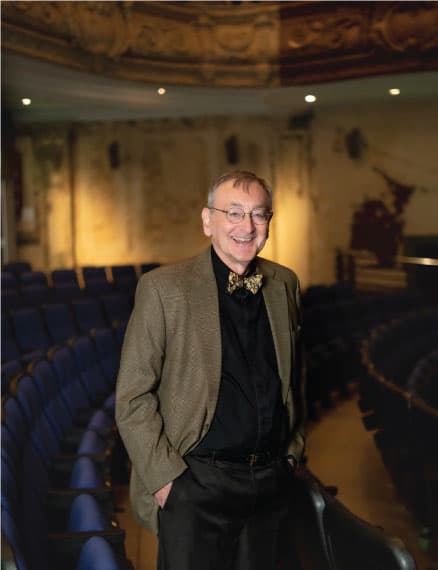Only Two Duets: Red Branch Does Not Solve The Last 5 Years’ Mysteries
Posted on BroadwayWorld.com April 6, 2014
The Last 5 Years is a treasure of the American musical theater, the quintessential chamber musical. Jason Robert Brown‘s mini-masterpiece boasts but two performers, a small musical ensemble, a challenging but moving score, and a simple but powerful structure designed to maintain dramatic equilibrium and balance between the characters from start to finish. Not surprisingly, it is often produced (34 productions announced this year – not to mention a film version).
Somewhat more surprisingly, it is very hard to get just right. I’ve seen three productions in the last decade, only one of which hit the mark squarely. The revival at Red Branch Theatre in Columbia is, regrettably, not one of them. That said, it is full of good things, and worth the ninety or so minutes the viewer will spend with it (no intermission).
Why is it so hard? Well, start with the music. It owes as much to modern classical composition as to the conventional musical stage, and requires the performers to come in at or leap to odd notes; in short it requires real “ears” of both performers. Also, dynamic balance between the singers and the instruments (piano, synthesizer, cello and bass here, though original scoring calls for a guitar and a violin) turns out to be hard to maintain, and on most stages, that means the singers better have enough volume to compete. Here, so far as I could tell the performers were unmiked, which was simply a mistake. Kurt Boehm as Jamie was up to the challenge, barely, but Jennifer W. Culotta as Catherine was not, wobbling frequently not only on volume but on pitch as well. There’s a moment where Catherine, a young actress, is trying out for a musical, protesting that the other aspiring performers are “belting as high as they can.” When Culotta imitates the belting, just for a moment she sounds the way she ideally would through much of the proceedings. Culotta is a fine actress, but from a singing standpoint, this show gets the better of her.
The pitfalls continue with the book and the lyrics. I’ve said that this show is a treasure, but it certainly has its imperfections, imperfections left up to the cast and the direction to remedy. The tale of a marriage from first kiss to the moment of separation, it leaves essentially unidentified the problems that cause the separation. What we see are more in the way of symptoms. Catherine is uncomfortable with her writer husband’s celebrity; she opts out of attending parties with him; their careers make them spend a lot of time in different cities; he has an affair. These are common kinds of incidents in breakups, but they do not explain the breakups; they do not explain how a couple who were originally propelled into each other’s arms by passion come to be so awkward and distant with each other. That part of the story is told in ill-connected snapshots.
For instance, in the song A MIRACLE WOULD HAPPEN, we see Jamie dealing with the temptation when other women flirt with him. But the challenge seems to be surmounted. He responds, “It’s fine, it’s fine, it’s fine,” which seems to end the train of thought each time. Yet four songs later (NOBODY NEEDS TO KNOW) he’s in bed with another woman. Why? What changed his mind? The fact that he had a fight with his wife? The fight doesn’t seem to be about sexual temptation, and he does not seem to be leaving the fight determined to do a marriage-annihilating thing like have an affair. Cathy seems to know of his infidelity in SEE I’M SMILING, the song that follows chronologically after Jamie is in bed with the unnamed other woman, and she does not appear to be treating it as a deal-killer; what drives her to distraction is his inattention to her. But we kind of want to understand her views about the affair.
We simply need more information.
The dramatic structure (his story is told going forward, hers going backward) worsens the problem, because there is only one point where the two characters are portrayed in the same moment of time, at their wedding, which is the midpoint of the show. That is a lovely moment, one of the two duets in the production (the other being the finale, as they part for the first time from her perspective, and the last from his). If the wedding scene is done right, and it is here, the audience can witness for a moment how the ways Jamie and Cathy speak and feel seem to make them right for each other.
Apart from that, though, even when Jamie and Cathy occupy the stage at the same time, they are not in the moment with each other, and there is no interaction to read. We cannot see them reacting to each other. This leaves the actors dealing with unseen interlocutors like characters in a movie face-to-face with Transformers or space aliens. But unlike the space alien movie, this show has no way even to insert the missing character “in post.” A really great production of the show will make you suspend disbelief in the absence of the other character, will compel you to see the other character there before you. And thus somehow you can sense the missing pieces of the story.
This is not that production. This time, what you see, in all its maddening lack of completeness, is usually what you get. It may not be fair that the show calls for alchemy, not just hitting marks. But that’s what it does.
The strength in this revival is Kurt Boehm, a talented actor and singer who can at least deliver all that the script and the score require and a bit more.
The Red Branch Theatre Company is putting on The Last 5 Years in repertory with Andrew Lippa and Tom Greenwald‘s john & jen as “The Love/Loss Cycle,” opening in two weeks’ time. It may well be that there are resonances between these shows worthy of consideration, a subject to be considered in these pages after john & jenopens.
In the meantime, with all the caveats already mentioned, this production certainly made the opening night audience happy; clearly the magic of The Last 5 Years carried the day.
Copyright (c) Jack L. B. Gohn, except for production photo


 I lived in London and Vienna before coming to the United States, and grew up mainly in Ann Arbor. I was writing plays and stories as early as grade school. My undergraduate years at the University of Pennsylvania, where I first reviewed theater, for the college paper, were succeeded by graduate study at the Johns Hopkins University, where I earned a doctorate in English Literature.
I lived in London and Vienna before coming to the United States, and grew up mainly in Ann Arbor. I was writing plays and stories as early as grade school. My undergraduate years at the University of Pennsylvania, where I first reviewed theater, for the college paper, were succeeded by graduate study at the Johns Hopkins University, where I earned a doctorate in English Literature.